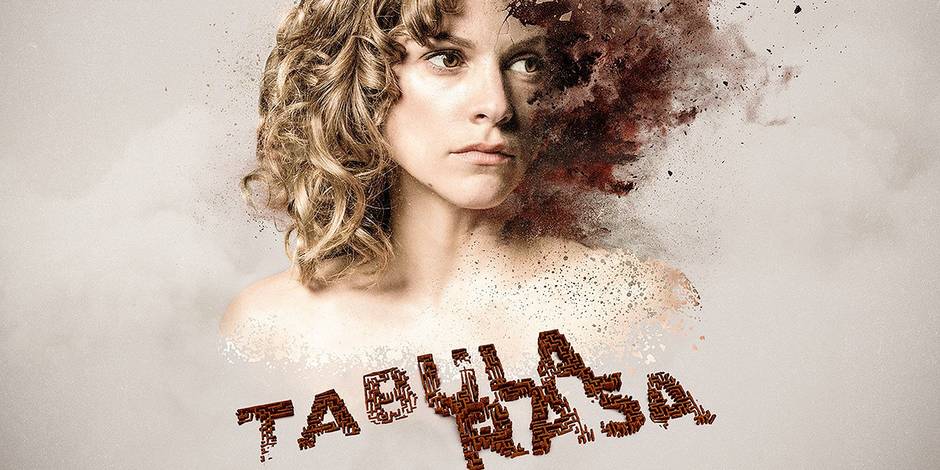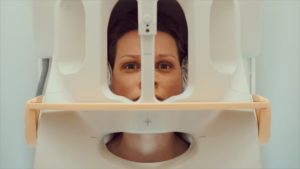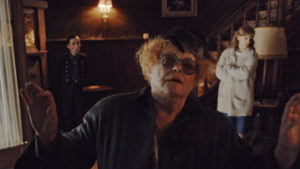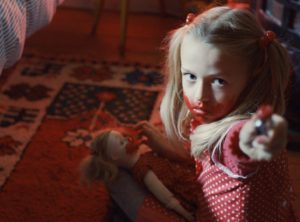
Tabula Rasa – Episode 4: De draad van Ariadne (Ariadne’s Thread)

Starring: Veerle Baetens, Stijn Van Opstal, Gene Bervoets, Hilde Van Mieghem, Cécile Enthoven, Jeroen Perceval
Directors: Kaat Beels, Jonas Govaerts
Writer: Veerle Baetens
Reviewed by Sidney Morgan
This review CONTAINS MINOR SPOILERS.
At the end of the last episode, we found out that Thomas de Geest is still alive. Someone is keeping him in the basement of the cabin Inspector Wolkers, and Mie visited. Though it’s clear that Mie remembers Thomas, there was no indication that she was aware of his location or even condition. The slower pace and relaxed atmosphere of episode three was short-lived as this one returns with increased intensity and sense of dread.

Ariadne’s Thread continues to focus on Mie’s memories, and as before, it leads to more questions. It begins with Mie at a photo lab store, picking up some pictures she had developed. Noticing something to be wrong with one of them (a bit more on that below), she complains to the owner. He states that the problem must be on her end, suggesting that her camera might be damaged. Mie agrees and asks if she could bring it in. He answers that they don’t do repairs anymore. Mie doesn’t argue and leaves. On her way out, the camera zooms in on a flyer taped to the door that advertises a 20% discount on camera repairs…
What’s going on here? Why did he lie? Or did he? Could it be that Mie’s memories are so messed up we can’t even be sure what’s true and what isn’t? Whether intentional or not, it makes the viewer pay closer attention to the action and question the accuracy of Mie’s memories. Nothing is certain given we see everything play out from her perspective.

Supernatural elements made a strong resurgence in this episode, though with ambiguity. There are no visible ghosts, slamming doors or jump out scares, but Mie is convinced that there’s a presence in the house and it’s affecting her daughter Romy. She and her sister Nikki find an Ouija board and engage in an impromptu session, apparently establishing communication with a spirit. Later, Mie hires a spiritual advisor of sorts, not unlike Zelda Rubinstein’s medium in Poltergeist, to investigate the house and rid it of any spirit. But as viewers, we can’t be sure what is real. Is there really some supernatural presence in the house? Or is this confabulation? The suspense generated is great.
Imagery continues to play a significant role. The flowing red sand blown or brushed away coinciding with Mie’s loss of memory. The tapestry in the upstairs room that resembles an unsolvable maze, akin to the memories locked away in Mie’s head. And there’s still Romy, who features a lot in this episode, and her red clothing. There are only two scenes in which she wears something of a different colour. It’s interesting that when in red, she’s more aggressive, yet when in white, much more passive and even a bit frightened. And what about the picture from the beginning of the episode? Why is Romy the only one (**SPOILER ALERT**) whose face is blurred? What does it mean? And why the heck does the shop owner lie to Mie?

Ariadne’s Thread, the title of this episode, implies that there’s hope for Mie. From Greek mythology, Ariadne was the daughter of Minos (a son of Zeus) and Pasiphaë (a daughter of Helios). After Minos attacked Athens for killing his son, Athenians were required to sacrifice seven sons and seven daughters every seven years to the Minotaur who dwelled in the labyrinth. Ariadne, who oversaw the labyrinth, fell in love with one of the sons, Theseus. To spare his life, Ariadne gave him a sword and a ball of thread, which he used to find his way out of the maze after slaying the Minotaur.
Today, it also refers to a problem-solving method for puzzles and mazes in which there are many ways to proceed, just like Mie’s puzzle. Key to this approach is the keeping of records to allow going back to tackle the problem from a different direction. Mie has been keeping records in her notebook, which she must do because of her memory issues. The director’s attention to detail is phenomenal as there’s a red bound bookmark in her notebook. Is it to symbolize Theseus’ ball of thread? Is this hinting that the solution to this mystery is in her notebook? And is there any significance to it being red?
Verdict: Must watch!
After letting us catch our breath, the intensity of Tabula Rasa is back. Though we know that Mie was acquainted with Thomas de Geest, there are so many questioned still unanswered. And every scene, regardless of who it’s with, can only be viewed with a heightened sense of suspicion as we can’t fully trust Mie. Tabula Rasa a brilliant show, one that Netflix seems to dare us to try and not binge watch.


![[REVIEW] FALLEN ANGELS #1](https://geekd-out.com/wp-content/uploads/2019/11/fallen-angels-1-featured-150x150.png)
